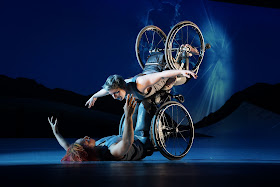 |
Left to right: Beth Gill, Jonathan Gonzalez, Miguel Gutierrez,
Angie Pittman and Edisa Weeks--artists who participated in
The Dossier Charrette in Reggie Wilson's platform at Danspace Project.
(Photo courtesy of Danspace Project) |
Reggie Wilson’s
Dancing Platform Praying Grounds: Blackness, Churches and Downtown Dance (Platform 2018 at
Danspace Project) is laden. It is complex. It is stuffed with history and geography and architecture and cultures and ancestral energies and choreography and ideas and imagery and walking around neighborhoods and...
stuff. As Black as one of my Bajan family’s festivities--the full range of meat and fowl, desserts and drinks, music and dancing and that one eccentric cousin holding court, as always.
How to take it in? How to make sense? How to interact and respond? Choose to sit on the outskirts and gaze from a critical distance? Or follow your curiosity, your empathy, your
bravery, throwing yourself into the deep?
Sink or swim, baby!
Maybe it’s wiser to break off a piece, here or there, to work with or be worked over by. You’ll have so many from which to choose.
During part of last Saturday’s
Bell & Water: a symposium--for which I performed a brief spiritual ceremony to open the afternoon--Wilson and his Danspace Project associates offered a guide to “How to Navigate the Platforms.” This concluding panel presented an overview of Executive Director/Chief Curator
Judy Hussie-Taylor’s groundbreaking curatorial initiative and a rundown of what to expect from Wilson’s current platform programming and its engaging catalogue. What it did not do--what perhaps could never be done--is extend a comforting, reassuring hand to anyone who might need to have things defined and neatly arranged for quick, easy consumption.
I’m thinking, this morning, about Wilson’s post-show conversations with his artists and how, each evening, he insists on passing around the dossier commissioned from historian
Prithi Kanakamedala to inform and possibly inspire the platform’s artists and how that document--which I have never held in my own hands--somehow always fails to make it all the way from one end of the audience to the other. I don’t know why Wilson insists in having people try to hand it around in the allotted time. Maybe to demonstrate that it--written down and lasting, central and centering--really exists? That there is an intellectual blueprint, if you want to call it that? Is that really necessary? To glance at a page or two for a few moments--though, clearly, people have been taking longer--before passing it to the guy to your right?
I’ll take the radical view that Wilson--who has said, any number of times, that he’s resistant to the way our Westernized worship of the written word demotes other ways of knowing and communicating--might relax a little and consider stepping back from this practice as well as from the practice of post-show discussions entirely.
Stop right there. Don’t be horrified. And make no mistake: I love Wilson and am a huge fan of his from way back. This is not a criticism. But after seeing each of a couple of the performance events in this platform, I would have been immensely grateful for complete silence--and even private time for recovery--so strong was the impact. I also sensed some hesitation and reticence in some of the artists as they attempted to answer questions and in most of the audience folks as they were asked for questions. Maybe everyone needed time for more than a few breaths to re-group, re-ground and let the energies and ideas inside the works settle in. Settle in and
continue the work that the best of dance can do.
Or maybe it’s just me. Maybe post-show talks are totally cool. But these seem forced. I don’t want to hear about and be directed by...so much...not just yet. But, you’ll say, you’re the woman who says she sat down and read the catalogue from cover to cover. Yes, in my own time, and in my own space, in privacy, so I could concentrate and take in and sift stuff. And the catalogue is a verbal as well as visual collage--mirroring what’s best about the platform format--and I could have read and gazed upon those pages in any order I desired. This time, I just chose to be all compulsively Virgo about it.
Go see the performances. There’s electricity and surprise and vivid performance--thinking now of dancemaker/performers like
Jonathan Gonzalez,
Angie Pittman,
Ni’Ja Whitson and
Same as Sister/
Briana Brown-Tipley and Hilary Brown--and a real feeling of works with open, organic life which will continue to bring out new things to share and ponder. Works not only glancing at once at history and into the future but gazing from the vantage points of multiple temporal, cultural and personal dimensions. Just find a portal that looks interesting and jump right in.
For full information on
Dancing Platform Praying Grounds: Blackness, Churches and Downtown Dance, click
here.
Danspace Project
St. Mark's Church-in-the-Bowery
131 East 10th Street (off Second Avenue), Manhattan
(
map/directions)
 Subscribe in a reader
Subscribe in a reader















